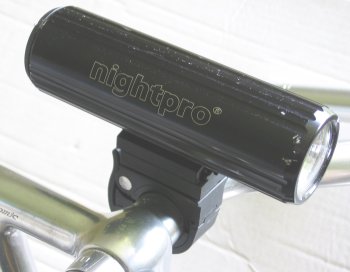[ 63XC.COM | REVIEWS | BULLITE ]
Just enough light
Cycling home at night, I occasionally meet The LightMan. The LightMan wears bright yellow reflectives and powers down the unlit lanes at uncanny speed on his audax bike. At least, I think it's an audax bike. I can't really get a look at it, because The Lightman's multiple headlamps are so dazzlingly bright that my response to his appearances is to veer off into the hedge, planting at least one foot and sometimes both while the red afterimage clears and my eyes recover their dark adaptation. In recent years, cycle lighting has provided consumer electronics firms with a lucrative new market. The benchmark is now in high-power rechargeables costing several hundreds of pounds. They cut through the velvet darkness of the Downs like car headlamps. I hate 'em. On the other hand, my move back to rural Hampshire has ruled out the low-cost solutions that served me in London. My old £20 CatEyes wimp out completely in the inky black of Hensting Lane, making the winter commute off the late train in 2005 something of an ordeal. I needed something stronger than the CatEyes, but I didn't want to become LightMan. After some research, I settled on the £70.00 Marwi Bullite. Like the CatEyes -- and unlike most upmarket sysems -- the Bullite combines power and light source in a single unit. However, it's a deal more substantial than any CatEye, being about the size of one of those narrow cans that they use for bar mixers or Red Bull energy drinks. The casing is mostly of CNC-machined aluminium, giving the unit the same satisfying rigidity as a decent hub. Despite the alu, the whole thing weighs well over half a pound. The heft is accounted for by the (proprietary) NiMH batteries tucked into the rear of the casing, leaving an inch or two at the business end for lamp, reflector and lens. At the rear is a pushbutton on/off switch and a socket for a transformer plug, both protected by rubber covers. (I'd have liked to see a similar cover for the lens so that I could backpack the unit without wrapping it.) There's a nice, positive push-on fitting so that you can click the whole thing onto a handlebar clamp. The box contains an instruction sheet, a charger, the aforementioned clamp, and that's about it. NiMH batteries must be stored charged, so I was able to flick the light on the moment I received it. It was clearly several steps up from the CatEyes, being bright enough to cast a spot even in full daylight. I attached the clamp to the flats of the MKM's handlebars and gave the light its first workout the same evening, on my route home from an outlying Oxford village to the rail station and then home off the train from Winchester. As you might expect, it takes patience to set up the Bullite. Mounted on the handlebar flats, the clamp can only be adjusted in the pitch axis by undoing it, but has a ratchet mechanism allowing some yaw adjustment. Getting the beam where I wanted it took a couple of iterations. Unmount, unclamp, adjust, reclamp, remount... Eventually, I got a nice tight beam over the area five to twenty feet in front of me. The ratchet was a bit problematic, perhaps because of the weight of the Bullite. It seemed easier than it should have been to knock the lamp off to the right or left. (In time, I suspect that I will end up with the clamp on the stem riser, locking the beam straight ahead and enabling me to set the pitch angle using the ratchet.) Once configured, light quality was pretty good. The spot showed up road debris and so on and the diffuse glow let oncoming vehicles know exactly where I was. Note the slight qualification on that 'pretty good'. The spot wasn't so intense or so far-projecting as to let me ride at full tilt into the darkness. But it was good enough to pedal on tarmac at a comfortable medium pace, which is what I was looking for. I even felt confident enough to pedal gently on the backroads and light trails of a medium-tough route, tho' not the flint-faced bridleway. The unit has continued to work well over the last few weeks. I've never yet flatlined the power supply, because the 90 minutes or so of burn time is enough to get me home comfortably. The plug'n'forget charger works well, too, although the lamp casing can get pretty hot at the start of a recharge -- you should probably keep it away from soft furnishings. Portability is more of an issue. Plenty of LED units with external lithium batteries are smaller and lighter than the Bullite. (On-One sells a nice one.) On the other hand, the Bullite seems like a survivior. It's easy to imagine digging it out of the bottom of my rucksack in five years -- not something I'd predict for the Dinotte. Would it work for you? Marwi describe the Bullite as a 'trail light' which is surely wrong -- I wouldn't use it for serious after-dark cross-country, if only because of the likelihood of knocking the lamp out of line during energetic cycling. But then, I don't want to do that kind of riding. (If you fancy wandering the countryside at night, you'll have less negative impact if you invest in a set of night vision goggles.) If your route home involves travelling bad roads in the dark and you don't mind slowing the pace a little, the Bullite is a fuss-free tool.
[ TOP ] |
Writer
Will Meister
Date
v1.0 written April 2006
Related
Marwi have their own site.
Mailing list
Join the 63xc.com list.
